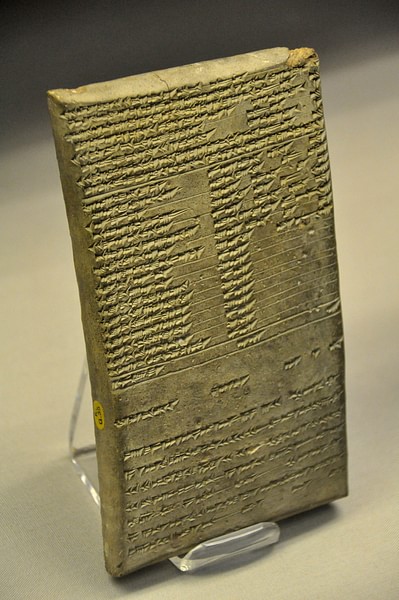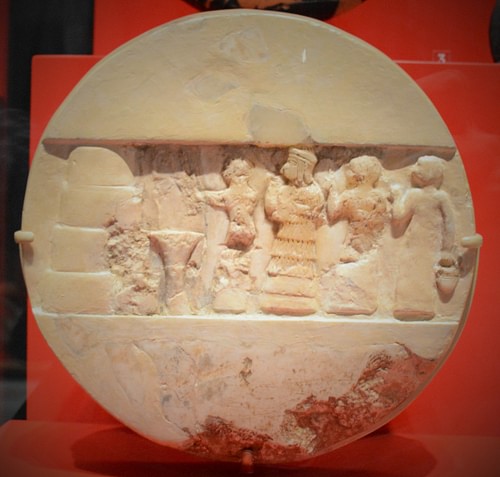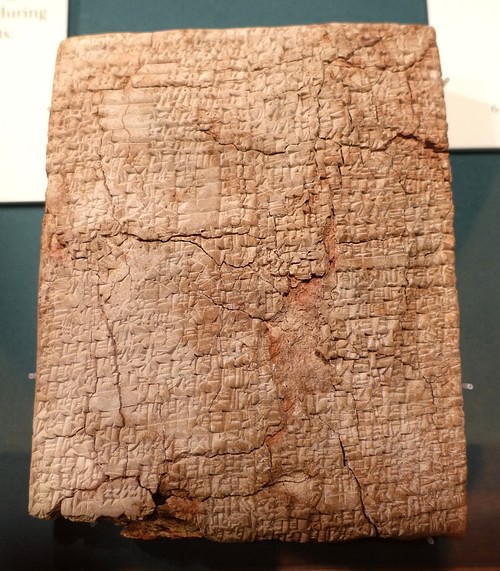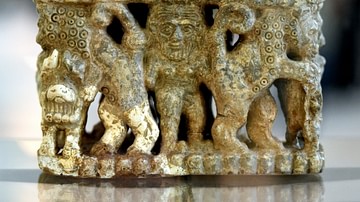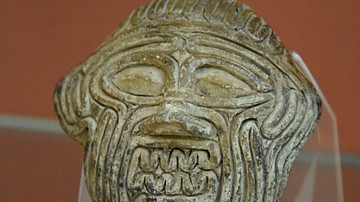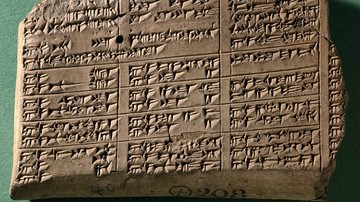
Ancient Mesopotamian Literature developed c. 2600 BCE after scribes, who had formerly been record keepers, began composing original works in the region of Sumer. The Sumerians invented writing c. 3500 BCE, refined the script c. 3200 BCE, and scribes may have begun composing their own works prior to c. 2600 BCE, but this is unclear.
Writing was created in response to the need to communicate over long distances in trade and, initially, was focused on the purely practical aspects of record-keeping. Scribes in ancient Mesopotamia recorded what commercial goods had been shipped to which destination, their quantity, purpose, and cost. In time, proto-cuneiform script developed into the 600 characters of cuneiform script, allowing for greater freedom of expression, and scribes were then responsible for creating inscriptions of the reigns and deeds of kings among other works such as legal documents.
Once the Sumerian scribes began writing, it seems, they could not stop and created works defined by modern-day scholars as poetry, wisdom literature, mythology, historical fiction, legends, incantations, hymns, prayers, meditations, didactic tales, and the earliest vision of The Epic of Gilgamesh, which would later be fully developed by the Babylonian scribe Shin-Leqi-Unninni (wrote 1300-1000 BCE). Sumerian was replaced as a living language by Akkadian after 2334 BCE, and scribes then composed in Akkadian cuneiform script, which was adopted and adapted by the Babylonians, Kassites, Assyrians, and others.
Modern scholars sometimes include history and legal codes in the definition of 'Mesopotamian literature' as these often contain references to supernatural entities, but for the purposes of this article, only imaginative works will be considered. In Mesopotamian literature, 'imaginative works' include religious poetry, as the words and deeds of the gods were depicted through poetic devices and imaginative settings. The works developed through the following eras in Mesopotamian history (though the Hittite and Kassite periods will not be addressed in this article owing to space limitations):
- Early Dynastic Period – 2900-2334 BCE
- Akkadian Period – 2334-2218 BCE
- Ur III Period – 2047-1750 BCE
- Old Babylonian Period – c. 2000-1600 BCE
- Hittite Period – 1700-1200 BCE
- Kassite Period – c.1595-c.1155 BCE
- Assyrian Period – c. 1307-912 BCE
- Neo-Assyrian Period – 912-612 BCE
- Neo-Babylonian Period – 626-539 BCE
- Achaemenid Persian-Sassanian Persian Period – c. 550 BCE-651 CE
The literature of ancient Mesopotamia is understood to have influenced the works of other civilizations, including those of Egypt, the Levant, Greece, and Rome.
Sumerian Literature
Scholar Jeremy Black, throughout his many works on the subject, maintained that Sumerian literature could not be dated precisely owing to a lack of objective, historical references in many of the pieces. Generally speaking, however, Sumerian scribes are thought to have begun composing original literature c. 2600 BCE. The Instructions of Shuruppag (also given as The Instructions of Shuruppak), the oldest philosophical work extant, is usually dated to c. 2000 BCE, but according to some scholars, it dates to c. 2600 BCE, which would make it the oldest extant written work in the world along with the Kesh Temple Hymn, also dated to c. 2600 BCE.
Fragmentary tablets of other works dated to that same period provide evidence of scribes signing their names to original compositions, and by c. 2150 BCE, literature in Sumer had been established through poetry, including works relating to the hero-king Gilgamesh. The Epic of Gilgamesh is dated to c. 2150-1400 BCE, even though the standard Babylonian version of the text dates from c. 1300-1000 BCE, because of the early Sumerian poems drawn on to create that work:
- Gilgamesh, Enkidu, and the Netherworld
- Gilgamesh and Huwawa
- Gilgamesh and the Bull of Heaven
- Death of Gilgamesh
- Eridu Genesis
The Sumerians not only invented writing but also literary forms, beginning with poetry, the oldest form of literature in the world. These five works became the original material from which the genre of epic poetry would be created. Eridu Genesis, the first appearance of the story of the Great Flood, would later influence other famous works including the Egyptian poem The Book of the Heavenly Cow and the tale of Noah's Ark in the biblical Book of Genesis.
Poetical works such as The Debate Between Sheep and Grain and The Song of the Hoe (both dated to c. 2000 BCE) established the form of the literary debate and praise poem, respectively, two forms used repeatedly throughout Mesopotamian history and then by other civilizations. Religious praise poems, such as the Hymn to Nisaba, set the form for later prayers, psalms, and hymns, while other Sumerian poems introduced styles, symbols, mythological motifs, and character types that have resonated in the literature of world culture ever since.
Inanna's Descent (also known as The Descent of Inanna, c. 1900-1600 BCE) is the earliest written evidence of the figure of the dying and reviving god (although the story of the Egyptian god Osiris may have existed earlier in oral form). Inanna and Su-kale-tuda (c. 1800 BCE) is a cautionary tale on the importance of treating others with kindness and a sharp condemnation of rape. Schooldays (c. 2000 BCE) and A Supervisor's Advice to a Young Scribe (c. 2000-1600 BCE) are early masterpieces of satire. The Hymn to Ninkasi, Goddess of Beer (c. 1800 BCE) combines praise of a deity with a recipe for brewing. All of these forms, figures, and themes, to greater or lesser degrees, would be used by later Mesopotamian scribes, who then inspired those of other cultures to do the same.
By 2334 BCE, the Sumerian city-states and kingdoms had been conquered by Sargon of Akkad (Sargon the Great, r. 2334-2279 BCE), who established the Akkadian Empire, and, by this time, the Sumerians had long established the edubba ("House of Tablets"), the scribal school which encouraged the study, copying, memorization, and recitation of literary works ranging in subject from the creation of the world to the will of the gods, romantic love, sex, politics, religion, and various aspects of daily life.
Akkadian Scribes & Sumerian Renaissance
Akkadian replaced Sumerian as a spoken and written language, but Akkadian scribes continued to copy, memorize, and expand upon Sumerian texts. Scribes studied both languages as part of the curriculum of the edubba in the same way later scholars in Europe would study ancient Greek and Latin. Literary works identified as 'Akkadian' in the present day are often Sumerian or Babylonian, just written in Akkadian cuneiform script. Cuneiform was inscribed by making wedge-shaped marks on clay tablets, but these wedges could be used to write any of the languages of Mesopotamia. The same method created by the Sumerians, therefore, continued in use.
The Akkadian scribes were not merely copyists, however, but created their own original works in the form of biographies, religious works, praise songs, and hymns. The most famous Akkadian scribe is Enheduanna (l. 2285-2250 BCE), daughter of Sargon of Akkad, who wrote 42 poems in addition to her famous praise songs, including the Hymn to Inanna. Her works influenced the development of later religious poetry, most famously the Psalms of the Bible.
One of the best-known examples of Akkadian literature is the Dialogue of Pessimism (c. 1000 BCE), which has been identified as a Babylonian text reworked by Akkadian scribes (as it would later be by Assyrians). This work of wisdom literature explores the meaning of life by asking why one should do anything. The poem features a master and his slave in a series of conversations in which the master proposes a certain action, like eating dinner, and the slave encourages him; then the master claims he does not want to eat dinner and the slave provides equally good reasons not to. The poem is a comedy, most likely acted out for an audience, but it also encourages one to question the final meaning of any activity at all.
Akkadian continued in use through the Ur III Period, also known as the time of the Sumerian Renaissance as this era saw a rebirth of and widespread interest in Sumerian culture and literature. Ur-Nammu (r. 2047-2030 BCE), founder of the Third Dynasty of Ur, encouraged literacy, and his policies were continued by his son and successor, Shulgi of Ur (r. 2029-1982 BCE) who had been trained as a scribe and composed original poetry. One of the most famous works, dated from Shulgi's reign (though the author is unknown) is The Death of Ur-Nammu honoring his father while also providing one of the earliest descriptions of the Mesopotamian afterlife and addressing the difficulties in coping with grief – whether on the earthly plane or in the underworld.
A Praise Poem of Shulgi was written to celebrate and immortalize the king's famous run of 200 miles (321.8 km) between Nippur and Ur in a single day and is also an example of original works honoring human achievement, not just a king's victories in battle or the goodness of the gods. Lullaby for a Son of Shulgi is considered the world's first lullaby, composed by an unknown scribe of Shulgi's court, or the king himself, for one of his children. Shulgi's policies regarding literacy led to the widespread establishment of scribal schools throughout his kingdom, which, in turn, resulted in a burst of creativity from the scribes in his region and elsewhere.
In the early 2nd millennium BCE, a new genre developed, known in the modern era as Mesopotamian naru literature, which featured a famous historical figure (usually a king) in a fictional tale. Among the best-known works from this genre are The Legend of Cutha and The Curse of Agade, but, according to some scholars, The Epic of Gilgamesh is also Mesopotamian naru literature. This genre developed from a long-established scribal duty: engraving a king's accomplishments on a stele (known as a naru). In Mesopotamian naru literature, the scribe simply took a famous historical king and inscribed his deeds just like always – only now those deeds were fictional, and the tale served to convey a moral lesson instead of glorifying the monarch. Some works, in fact, present the king in a negative light. In this way, the Mesopotamians invented historical fiction.
Babylonian Scribes & Libraries
Akkadian and Babylonian scribes were educated according to the precepts established by the Sumerians, and in cities such as Ur, Uruk, and Babylon, literacy flourished. Babylonian literature continued the tradition of preserving Sumerian works while creating new ones which would then influence later writers. The Ludlul-Bel-Nemeqi ("Poem of the Righteous Sufferer"), a Sumerian poem dated to c. 1700 BCE (and later rewritten and extensively developed by Babylonian scribes c. 1307-1282 BCE) is a meditation on the meaning of suffering and why bad things happen to good people, and it is understood as influencing the later biblical Book of Job. Ludlul-Bel-Nemeqi, in turn, may have been influenced by the Dialogue Between a Man and His God (dated c. 2000-1600 BCE), which deals with this same theme or, depending on the dating one accepts, could have been the inspiration for that work. Scribes would have had access to earlier works through public libraries or their own private collections.
Libraries were firmly established by the time of the Old Babylonian Period, usually as part of the temple complex but also in scribal schools, and it was the responsibility of the head librarian (or keeper of the temple library in the complex) to preserve the collection, replace lost or damaged works, and add new works by locating and having them copied. One example of this, among many, is the poem The Poor Man of Nippur. The extant copy is dated to 701 BCE, but, according to some scholars, the story dates to c. 1500 BCE or earlier. It was almost certainly originally a Sumerian work, written in Akkadian script, and then copied for a library's collection in Babylonia. The scribe Shin-Leqi-Unninni, famous as the author of The Epic of Gilgamesh, would have been one of these scribes, working for a scribal house or temple, copying works while writing his own originals.
Scholars continue to debate whether there were private libraries in people's homes in ancient Mesopotamia, but this argument seems pointless. It has already been established, through the excavation of the library of the Neo-Assyrian king Ashurbanipal at Nineveh, that some tablets were taken from personal libraries. Ashurbanipal (r. 668-627 BCE), like Shulgi of Ur, was trained as a scribe, wrote his own works, and established the library at Nineveh to preserve the whole history and culture of Mesopotamia. He sent his couriers throughout the Assyrian Empire to find, copy, and collect books. Although ancient Mesopotamian works have been found at many Near East sites in the modern day, some of the most important have come from the ruins of the library at Nineveh.
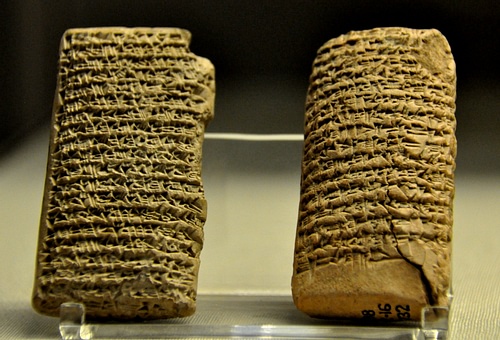
Assyrian Works
Ashurbanipal was the last great king of the Neo-Assyrian Empire, which produced its own literary works, but Assyrian scribes had been engaged in creating original compositions since shortly after (or during) the reign of the Assyrian king Adad Nirari I (1307-1275 BCE) with The Adad-Nirari Epic. The tablets of this work are badly damaged, so it is impossible for modern scholars to tell whether it is strictly historical or more along the lines of Mesopotamian naru literature, but the story concerns the king's victory in battle over the Babylonians.
This epic may have been inspired by the Anitta Text, written by the Hittite king Anitta (r. c. 1740-1725 BCE), a trained scribe and the first to compose a work in the language of the Hittites. The Anitta Text records the king's great military victory and praises him as a mighty warrior, which was standard of inscriptions of king's reigns, but the legible parts of The Adad-Nirari Epic seem similar to the Anitta Text, though a definite link between the two is purely speculative.
A more complete Assyrian work is the Tukulti-Ninurta Epic (c. 1200 BCE), featuring the king Tukulti-Ninurta I (r. 1244-1208 BCE) and praising his victory over the Kassite king Kashtiliash IV (r. c. 1232-1225 BCE) who ruled from Babylon. In this work, Kashtiliash IV breaks his treaty with Tukulti-Ninurta I, and the latter shows mercy, hoping to avoid armed conflict. When Kashtiliash IV refuses his overtures of peace, Tukulti-Ninurta I leads his army against the Kassite king, defeats him, and brings the spoils of war back to his capital where they are offered in homage to the gods.
Both epics focus on military victories, but Assyrian scribes were also at work revising earlier Sumerian and Babylonian pieces as well as continuing their regular duties. Among the most important of these, for the palace scribe, was making sure the king's inscriptions were engraved in a timely manner and the best example of this is the story of the greatest party ever thrown: Ashurnasirpal II's Kalhu Festival of 879 BCE. Ashurnasirpal II (r. 884-859 BCE) threw his grand party to inaugurate his new city of Kalhu and then commissioned his scribes to immortalize the event in writing. History, legal codes, agricultural documents, legal documents, political decrees, and others still occupied the scribes, and yet, to their credit, they made the time to work at their craft in creating original compositions.
Among the most famous of these from the Assyrian Period is The Epic of Ishtar and Izdubar (also given as The Epic of Izdubar) dated to the reign of the Neo-Assyrian king Sargon II (722-705 BCE) and found in the ruins of his city of Dur-Sharrukin. The work is a retelling of The Epic of Gilgamesh but makes significant changes. In Gilgamesh, the hero's companion is the wild man Enkidu, here he is the sage Heabani. The heroes do not defeat the demon-monster Humbaba in this version, but a king named Khumbaba. There is also no mention of the Great Flood. Assyrian scribes reworked many earlier pieces including Descent of Inanna which they changed into Ishtar's Descent to the Underworld.

Conclusion
The Persians continued the same tradition of literacy and the preservation of the past, but the definition of 'Persian literature' is debated by modern scholars. Some scholars claim Persian literature dates from c. 522 BCE and the Behistun Inscription of Darius I (the Great, r. 522-486 BCE), while others cite the destruction of the library at Persepolis c. 330 BCE by Alexander the Great, which eliminated any evidence of early Persian literary works. These scholars claim Persian literature can only be dated from the time of the Sassanian Empire (224-651 CE) when the Avesta was set down in writing and the vision of Zoroastrianism inspired poetic works and commentary. Most scholars date Persian literature from c. 750 through the 15th century CE, beginning with the rise of the Abbasid Dynasty.
The long literary tradition of Mesopotamia was continued by the Persians, however, and the legacy of storytelling honored further in the medieval period through the epic work Shahnameh – The Persian Book of Kings – by the poet Abolqasem Ferdowsi between 977-1010 CE. The Shahnameh, like The Epic of Gilgamesh, is recognized as one of the greatest works of world literature, inspiring many others which continue to engage readers in the present day. These pieces, however, and the many others, would never have existed if ancient Sumerian scribes had not, at one time in the distant past, left off the mundane tasks of everyday life to devote themselves to creating works of the imagination.
